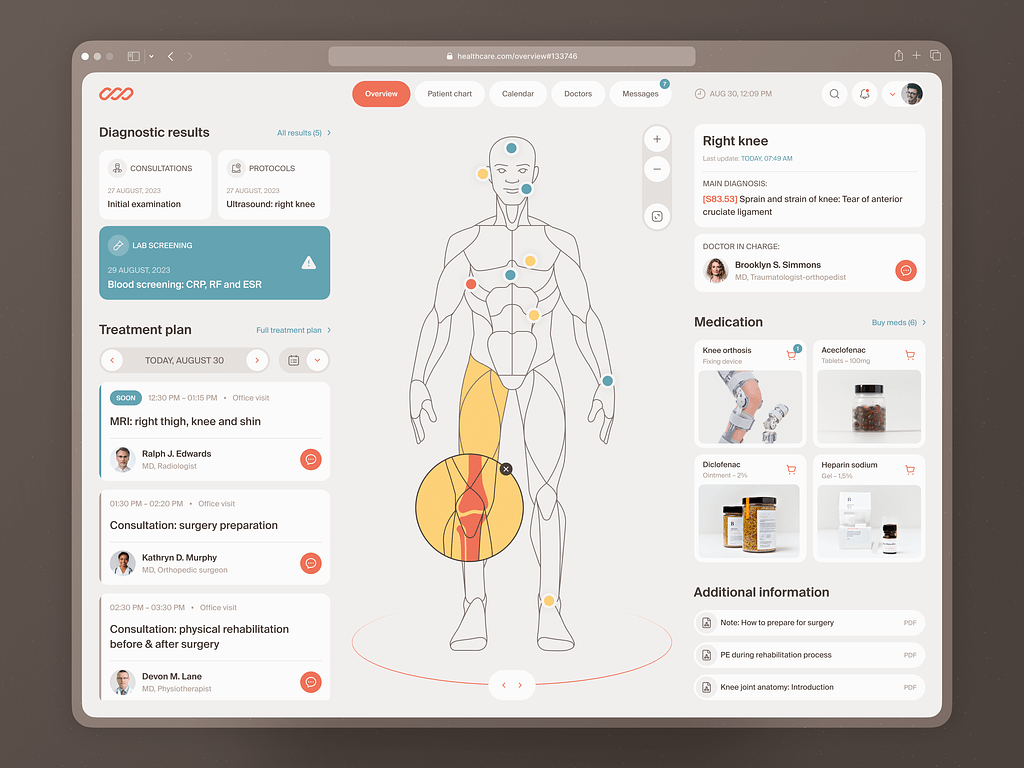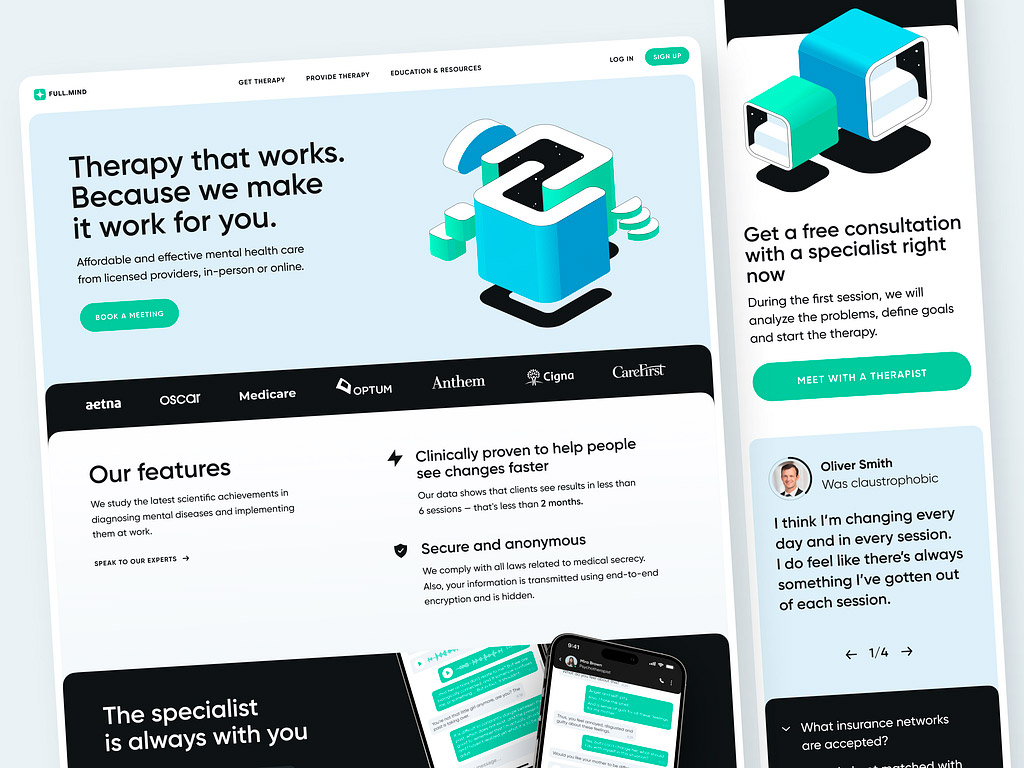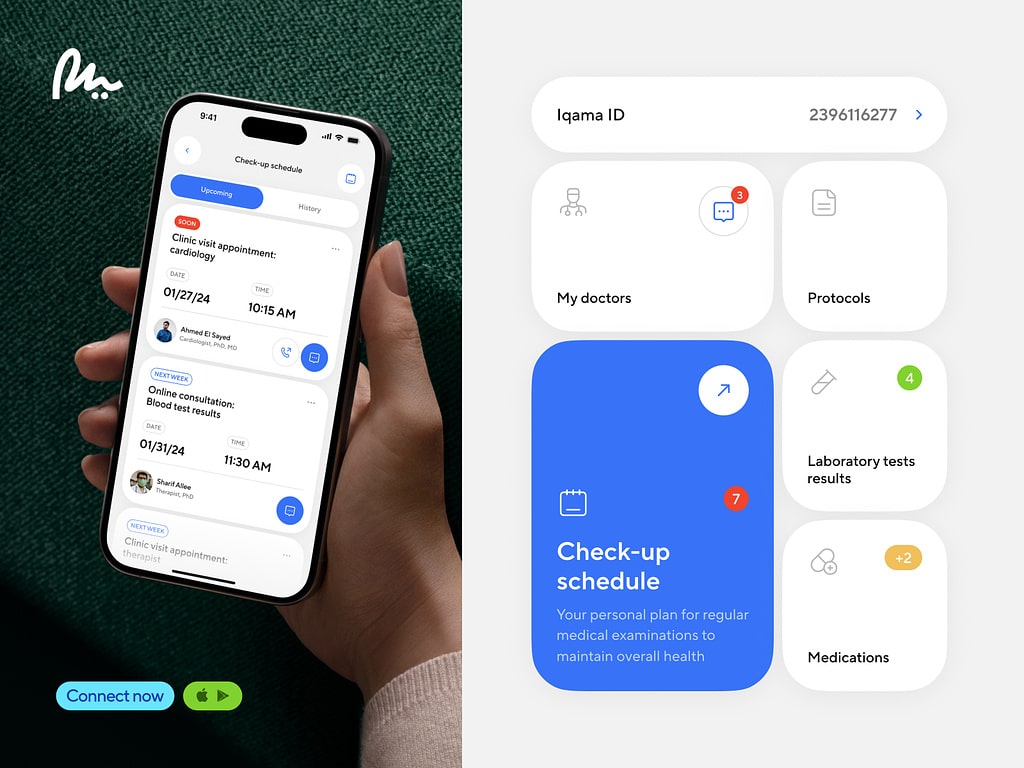Is healthcare software development on your radar? While it might not be making the headlines, did you know it’s a booming industry, worth billions and still growing strong?
Contents:
Thanks to new technologies like telemedicine and artificial intelligence, it’s changing the future of healthcare in a major way.
What came up as a response to the urgent requirements of the COVID-19 pandemic has become a smart, cost-effective way to support healthcare professionals and meet patients’ demands on a large scale. More and more healthcare organizations are using technology to improve their services, be more innovative, and stay ahead of the game.
If you’re reading this, odds are you’re thinking about getting healthcare software for your business. We get it– it’s a big decision. With so many options out there, picking the right system is super important. You don’t want to waste money or have unhappy patients or a messy workplace.
Healthcare Software Market
Just think about this: By 2030, experts think the global IT healthcare market will be worth more than a whopping USD 870 billion! It is expected to grow at a compound annual growth rate of 15.8% from 2024 to 2030.
Physicians’ usage of electronic patient record software is one example of the growing acceptance of eHealth solutions. While just about 18% of office-based doctors in the United States used such systems in 2001, a few years later, the figure had risen to roughly 88%.
Over the last decade, investor financing in healthcare software has skyrocketed. In 2020, more than $21 billion were invested in the business, up from roughly $1 billion in 2010.
mHealth market is also on the rise. It grows at a GAGR of 10.6%, and by 2034, the USA will hold around 33.5% of its market share.
Here are some key healthcare trends shaping the market:
- The adoption of telemedicine software has surged, allowing patients to access medical consultations remotely. This trend has opened new avenues for healthcare delivery, making it easier for patients to connect with providers.
- AI and machine learning technologies are integrated into healthcare applications for predictive analytics, diagnosis assistance, and personalized treatment plans. These technologies are revolutionizing how patient data is analyzed and used.
- Devices such as smartwatches and fitness trackers are gaining popularity, enabling continuous health monitoring. This trend supports preventive measures and encourages lifestyle modifications.
- There’s a growing need for systems that can exchange and interpret data across different platforms. Interoperability enhances collaboration among healthcare providers and improves patient care.
- The shift towards patient-centered models is changing how services are delivered. Technology offers personalized care experiences, empowering people to make insightful decisions.
- Although still in its early stages, blockchain is being explored for secure data sharing and enhancing transparency in healthcare transactions, which could significantly influence trust and efficiency in the system.
- Applications focusing on mental health and well-being are gaining popularity, providing users with resources, therapy options, and community support.
Now let’s take a look at 6 types of healthcare software to keep an eye on in 2024.
Types of Healthcare software
Electronic Health Record (EHR) software
EHR software is hands down one of the top picks among hospitals and clinics. Think of it like a special version of CRM (Customer Relationship Management) solution, but made specifically for the medical world.
Instead of going through paper files, doctors and nurses can access everything they need with just a few clicks. It’s a game-changer for keeping track of patient information and making sure everyone’s on the same page.
With this electronic medical record software, doctors can easily look up a patient’s medical history, lab results, and notes from past appointments. This saves time and helps provide better care because all the important details are right there at their fingertips.
Features:
- Tracking patients’ status
- Automating appointments
- Generating document efficiently
- Issuing smart prescriptions
- Analyzing reports and information for insights
Benefits:
- Ensuring secure transmission of patients’ data
- Speeding up diagnoses and minimizing errors
- Cutting down on paperwork and time spent
Avg. cost of software development: $50,000 to $100,000
Examples: One of the largest EHR software vendors, Epic is widely used by large healthcare organizations. It offers comprehensive solutions for patient management, scheduling, and billing.

Medical Check-In Web Dashboard by Shakuro
Hospital management software
We’re talking about making things run as smoothly as possible in all healthcare organizations. It helps with everyday tasks like sorting out bills and scheduling patient visits. By connecting with electronic health records, hospital management software makes handling patient information easier and more personal.
But more than being efficient, it’s about making patients feel taken care of. This healthcare software makes the experience of going to the hospital easier and friendlier for patients. It helps doctors schedule appointments in a way that makes sense for patients, so they get the help they need when they need it.
Features:
- Helps patients register, get admitted, and handle bills
- Gives patients access to portals and easy-to-use dashboards
- Organizes hospital wards and assigns beds
- Keeps track of digital images and diagnostic reports
Benefits:
- Saves time and money wherever possible
- Improves patients’ experience
- Keeps patients’ data safe and secure
Avg. cost of software development: $80,000 to $250,000
Examples: McKesson offers a range of healthcare management solutions, including hospital management software that streamlines operations, improves patient care, and enhances overall efficiency.
Telemedicine software
It’s a key player in the healthcare industry, but it might not be the flashiest tech. Its software lets patients connect with doctors remotely, using video calls, messaging, or other online tools.
Telemedicine software is like having a virtual doctor’s office on your mobile! Instead of walking to a clinic, you can chat with your doctor from the comfort of your home. Amazing, right?
And here’s the best part: it’s not just convenient– it’s also very important, especially during times like the COVID-19 pandemic when visiting hospitals or clinics wasn’t always safe or practical.
But telemedicine software isn’t just about convenience and safety– it’s also about making healthcare more accessible. For people living in remote areas, telemedicine can be a blessing, giving them access to quality healthcare without having to travel long distances.
Features:
- Calls using audio and video
- Electronically issues prescriptions and handles payments
- Books appointments remotely
- Communication methods that follow HIPAA regulations
- Analyzes and manages patient information
Benefits:
- Faster treatment with minimum exposure
- Easy access to medical care
- More flexibility and increased revenue potential
Avg. cost of software development: $80,000 to $200,000
Examples: A leader in telehealth services, Teladoc provides various solutions for virtual care, including video consultations and chronic care management.

Healthcare Website Design Concept by Conceptzilla
E-prescribing software
Gone are the days of physically going to the doctor’s office for a paper prescription, now, with this solution, you can handle it all online. The software lets you connect with your doctor and request prescriptions without leaving your home.
What’s even better is that e-prescribing software not only manages the latest prescriptions but also keeps track of your medical history, including past prescriptions and allergies. That’s right!
And if all that wasn’t enough, some of these programs even remind you when it’s time to take your medication. It’s like having a little helper to make sure you don’t skip your daily dose.
Features:
- Sends prescriptions straight to pharmacies.
- Checks a patient’s medication history, and shows past treatments and how well they worked.
- Enables feedback that lets patients ask questions, share reviews, and learn about side effects.
Benefits:
- Reduced errors in prescription drugs
- Minimized mistakes in clerical work
Avg. cost of software development: $50,000 to $150,000
Examples: DrFirst’s e-prescribing software provides tools for medication management, adheres to regulatory standards, and features real-time prescription decision support.
Health Tracking Apps
You’ve probably come across apps like ‘MyFitnessPal’ and Apple Health. Now, think of these mobile health apps as personal assistants for managing your health, easily accessible on your smartphone or smartwatch. They help you keep track of things like your exercise, diet, and even the quality of your sleep.
By using these apps, you can get insights into your health and make much better decisions about your lifestyle.
Moreover, these applications can also remind you to take your medications, track any symptoms you might have, and even connect you with your doctor. Some apps such as ‘Flo’ even use fancy technology to give you personalized tips for staying healthy. Sounds awesome, doesn’t it?
Features:
- Personalized experience
- Activity summaries
- Enables engagement with the community and sharing on social platforms
- Push notifications
- Goal setting and monitoring
Benefits:
- Keeps all your health information organized in one app
- Lets you take charge of your health and wellness
- Syncs data seamlessly across multiple devices
Avg. cost of software development: $30,000 to $100,000
Examples: MyFitnessPal is one of the health tracking apps that help users track diet, exercise, and weight loss goals. It boasts a vast food database and barcode scanner for easy logging.

Remedy landing pages by Conceptzilla
Medical billing software
It takes care of the paperwork involved in billing for medical services. The solution uses certain templates and electronic payment systems to generate invoices and send out insurance claims. This means less time spent on paperwork and fewer mistakes.
Plus, it helps healthcare providers make sure they’re following all the rules and regulations when it comes to billing. This is important to avoid any problems with regulators and make sure they’re getting paid properly for the services they provide.
In a nutshell, healthcare billing software makes life much easier for healthcare providers and allows them to spend more time helping their patients and less time dealing with paperwork.
Features:
- Verifies eligibility
- Payment notifications
- Electronic payment records
- Processes claims
Benefits:
- Reduces manual work, paperwork, and chances of mistakes
- Enhances patient experience
- Provides quick access to funds
Avg. cost of software development: $80,000 to $250,000
Examples: Kareo is a cloud-based medical billing software designed for small to mid-sized practices. It offers billing services, scheduling, and patient management features.
Remote patient monitoring software
RPM has taken the healthcare industry by storm by allowing doctors to gather patient data from home instead of just at clinics or hospitals. This technology helps doctors get a more detailed health report and make diagnoses without needing an in-person visit. Convenient, right?
During the pandemic, Remote Patient Monitoring became even more popular because regular healthcare visits were a little harder to manage.
The best part? RPM uses devices like heart rate and blood pressure monitors, wearable ECG monitors, and tools to measure glucose and oxygen levels. These devices let doctors keep an eye on their patient’s health in real time, alerting them to any issues immediately and ensuring patients get the treatment they need right away.
Features:
- Tracking health in real-time
- Setting up IoT devices
- Securing patient data
- Digital communication tools
Benefits:
- Provides reliable and precise patient information
- Follows robust cybersecurity protocols
- Makes data accessible from any location, at any time
Avg. cost of software development: $80,000 to $280,000
Examples: Biotricity provides Remote Patient Monitoring software tailored for cardiac monitoring, including remote ECG and patient data management.

Helping Minds Healthcare Mobile App Concept by Shakuro
Medical imaging software
Ever wondered how doctors interpret medical images so easily? They do so with the help of medical image analysis software. This is like a smart tool that helps doctors see and understand medical images better and also design 3D models. These images can include X-rays, CT scans, MRI scans, ultrasound pictures, and more.
Moreover, medical 3D imaging software allows:
- Making 3D models of the human body: This software lets medical professionals create custom models for each patient. For example, they can use it to build a detailed model of a patient’s heart before a complex surgery to plan a better course of action.
- Printing medical equipment or body parts: This software helps print parts of medical devices or body parts, like artificial limbs or stents used in heart surgeries.
Features:
- Assists with comprehensive medical diagnoses
- Helps plan better treatments
- Spots abnormalities in images that do not display obvious anomalies
Benefits:
- Reduces clinical errors
- Decreased radiation exposure for patients
- Improved recovery/survival chances
Avg. cost of software development: $50,000 to $300,000
Examples: OsiriX is a widely used healthcare software tailored for viewing and analyzing DICOM images. It’s especially popular among radiologists.
Appointment scheduling software
Simply put, it helps hospitals, clinics, and medical offices handle all their appointments online. The product lets patients schedule appointments using an app or website, plus it sends emails and reminders to both doctors and patients about upcoming appointments. Sounds like a good deal for both parties, right?
Features:
- Online scheduling
- Automated reminders
- Calendar integration
Benefits:
- Makes scheduling easier
- Reduces no-shows
- Keeps things organized
Avg. cost of software development: $100,000 to $150,000
Examples: Acuity Scheduling is appointment booking software that offers customizable scheduling features, client management, and payment processing, perfect for service-based businesses.
Personal health record software
The product puts your medical history at your fingertips, making it easy to track and manage your health journey. Think of it as a digital health diary. It helps you store all your medical information in one place, like your medical history, test results, medications, and appointments. You can access it whenever you need, from anywhere. This way, you’re in charge of your health information and can share it with your doctors and family members easily.
Features:
- Putting data on the cloud and making it accessible on mobile
- Keeping track of both patient and doctor details.
- Custom telehealth and telemedicine
Benefits:
- Makes it easier to gather patient information
- Increases patient engagement
- Enhances communication between patients and healthcare providers
- Improves family health management
Avg. cost of software development: $30,000 to $100,000
Examples: Carezone is personal health record software useful for tracking medications, creating health journals, and managing family health records. It supports medication reminders and a shared care team feature.

Arabic Health App by Shakuro
Summary
We’ve covered how technology is changing healthcare for the better, with a special focus on the role of healthcare software.
Shakuro, a leading web and mobile design and development agency, understands the importance of these software solutions. That’s why we’ve just explored 10 different types of healthcare software, like electronic health record software, e-prescribing and medical billing systems, health tracking apps, medical imaging software, remote patient monitoring software, personal health record software, and EHR Software, and how they make our lives easier and safer for everyone involved.
As experts in web and mobile design and development, Shakuro is here to build custom software solutions just for you. So if you want to take your healthcare services to the next level, don’t hesitate to reach out to us today. Let’s work together to make healthcare simpler and accessible for everyone across the globe!
